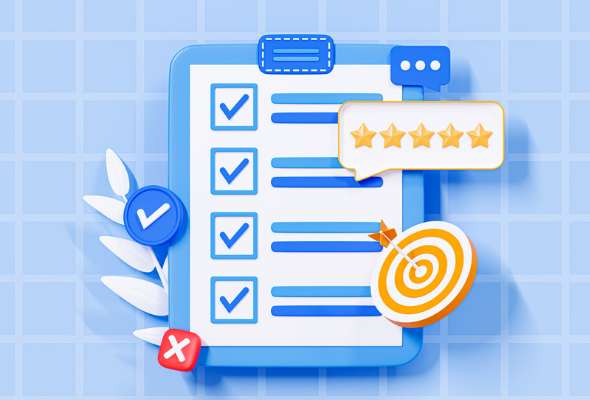
What Factors Should Organizations Consider Before Outsourcing Their Internal Audit Functions?
+91 1141182211 Outsourcing has become a strategic choice for many organizations looking to streamline operations, reduce costs, and enhance efficiency.

The survey data collection industry is huge and plays a vital role in organizations’ hiring candidates or offering services to their target audience. There is no denying that data is valuable. It provides profound insights into previous occurrences as well as future projections. Both these aspects make the survey a valuable resource for social and economic knowledge. However, data can only be beneficial if it is accurate and dependable.
Surveys are widely used in research to collect information from a pre-defined set of respondents, particularly in the social sciences. This procedure serves a variety of goals and is carried out by the methodology chosen. A survey comprises data collection using questionnaires, QR codes, or other social networks. However, there are cases where survey errors happen, which can bring information gathering to a halt. A lack of tools and ideas can result in survey errors.
Survey errors might occur while developing, deploying, configuring the parameters, or targeting the audience. Different errors take place, and each is different. It might be anything from a typo, adding incorrect answer options to a question, or incorrectly evaluating the findings.
If you’re wondering how grave an error can be, consider this: A small mistake in targeting, ordering, or selecting questions, or even in how you construct questions, can irreparably harm the quality of your feedback data and, as a result, your analysis.
This article presents some survey errors and how you can get away with them to ensure you get the correct data.
Including too many questions in your surveys will create a frustrating situation for respondents, regardless of your real and sincere desire to collect as much data as possible. There can be a situation where the respondent avoids answering the question. The best way to avoid this error is to finalize a sequence of questions that will provide detailed insights.
However, somewhere along the way, you lose sight of what to ask and add a slew of questions that make sense at the time.

However, they are only baggage for your overall survey, and you can get accurate feedback even if you do not include such questions. The best is to use skip-logic to guarantee that you only ask the appropriate queries to the appropriate clients.
If you believe all the survey questions are necessary and cannot be deleted, try breaking them into short surveys, making the respondent feel comfortable. You can include them at various times along the client journey.
When developing surveys, it is typical to create confusion between single-choice and multiple-choice questions (MCQs). There are several answer alternatives for single-choice questions, but only one correct answer. Multiple-choice questions, however, allow you to select more than one alternative. For instance, if you are running a hotel chain and want to introduce pet grooming services. So, you will need to create a survey asking customers different questions in single- and multiple-choice formats.
The best is to provide a multiple-choice question, having checked answers here so that customers with numerous pets can answer appropriately. Still, instead, you include a single-choice answer option with a radio button. Consider the responses you might receive once you have learned how to ask for specific input. It is easy to pick which type of answer is best for your survey question when you correctly anticipate the responses you may receive.
One of the companies’ major survey errors is using complex languages. Regardless of who is taking your survey, avoid using jargon or technical phrases that may confuse your respondents, and instead, use simple and uncomplicated English.
If you want to use complicated phrases, give clear descriptions and examples to help readers grasp them. It would be best if you spoke in a language your target audience would comprehend. For instance, consider the following questions. Increase the reply-to-ratio; the second question provides additional clarity for anyone who is slightly unclear about what the first question means.
It’s already challenging to attract more customers to conduct surveys and adding more than the needed open-ended questions only adds to the difficulty.
Example: Customers must provide extensive responses to open-ended inquiries. Assume you want to know what your customers think of your website and the overall experience of their navigation.
You would need a full description of each feature to understand how you treat your customers, but your customers need something else. More open-ended questions require more work and time to answer, which are signs of good surveys with a high completion rate.
The best you can do is collect in-context feedback by asking many close-ended questions followed by a follow-up question. You can also add a skip option so that clients aren’t forced to answer questions they don’t want to.

Try to avoid it, even if it’s as simple as leaving out the introduction to your survey. There are several causes for this. First, a good opening gives a taste of what and why this survey is the best way to get your audience’s attention.
Secondly, if you avoid introducing your survey, your respondents may feel uneasy or even suspicious about the purpose of your survey and opt out entirely. A clear and simple explanation of the purpose of your survey, in the beginning, will help get people interested and get them to read on.
It would help if you stayed calm when getting survey incentives. After you’ve spent time picking your questions, the last thing that happens is rushing to distribute your survey and running the risk of not getting the results you intended because the overall process needs to be corrected.
Even if you are an expert in the subject of your questions, it will be difficult to predict how recipients will respond to them without further investigation. However, you can take the right steps to get some results.
Rephrase your questions and suggest having a few co-workers verify them and tell you how they would respond. The best thing to do is to evaluate the survey questions created with your close friends. It could be anything from figuring out how your questions fit together and how long it takes people on average to answer each one to determine how your questions are put together and if anyone got them wrong.
After going through all the above points, we hope you see how critical it is to get your terminology and questions correct, add an intriguing survey beginning, and avoid finishing your survey project.
Finally, if you have given yourself enough time to develop and evaluate your survey, you can identify anything essential to raising the effectiveness of the survey. MIMOIQ is helping companies gain access to audience mindsets towards products or services through our survey and data collection services.
Like this article?
More To Explore

What Factors Should Organizations Consider Before Outsourcing Their Internal Audit Functions?
+91 1141182211 Outsourcing has become a strategic choice for many organizations looking to streamline operations, reduce costs, and enhance efficiency.

Outsourcing Internal Audit: Evaluating the Upsides and Downsides for Your Organization
+91 1141182211 In today’s dynamic business environment, companies face increasing pressure to enhance efficiency, manage risks effectively, and ensure compliance

A Background Verification Guide: Frequently Asked Questions and Their Answers
+91 1141182211 Background verification (BGV) is a crucial process used by employers to ensure they are hiring candidates with accurate